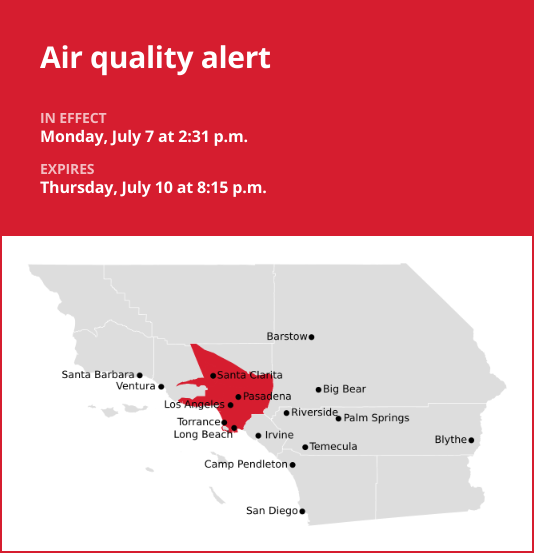5 Freeway north of LA is the focus of an air quality alert reported at 2:31 p.m. on Monday by the National Weather Service. The alert is in effect until Thursday July 10, at 8:15 p.m.
The NWS Los Angeles/Oxnard CA states to prepare for, “The South Coast AQMD has issued an air quality alert due to harmful levels of ozone pollution.”
“Ozone air pollution can cause serious health problems, including trouble breathing, asthma attacks, and lung damage. Everyone can be affected, but sensitive groups such as people with lung disease, older adults, people who are pregnant, children, and those who spend a lot of time outdoors are at greater risk,” the NWS said.
The full list of affected locations includes:
- 5 Freeway corridor near Santa Clarita
- Calabasas/Agoura Hills
- San Fernando Valley
- Eastern San Gabriel Mountains
- Eastern Santa Monica Mountains Recreational area
- Los Angeles County Beaches
- Los Angeles County Inland Coast including Downtown Los Angeles
- San Gabriel Valley
- Santa Clarita Valley
- Santa Susana Mountains
- Western San Gabriel Mountains/Highway 14 Corridor
- Western Santa Monica Mountains Recreational area

Guidance for air quality alerts: Insights from the NWS
When an air quality alert is in effect, following the NWS guidance is pivotal. Here are some simple tips from the NWS for safeguarding your well-being:
Seek shelter indoors when possible:
If possible, remain indoors, especially if you have respiratory issues, other health concerns, or fall within the senior or child demographics.
Curb outdoor exposure:
When venturing outside becomes unavoidable, limit your outdoor exposure strictly to essential tasks. Reducing your time outdoors is the name of the game.
Mitigate pollution sources:
Be conscious of activities that contribute to pollution, such as driving cars, using gas-powered lawnmowers, or relying on motorized vehicles. Curtail their use during air quality alerts.
A ban on open burning:
Avoid burning debris or any other materials during air quality alerts. This contributes to worsened air quality.
Stay informed:
Keep yourself well-informed by tuning in to NOAA Weather Radio or your preferred weather news outlet. Staying in the loop empowers you to make informed decisions regarding outdoor engagements during air quality alerts.
Prioritize respiratory health:
If you have respiratory problems or underlying health conditions, exercise extra caution. These conditions can increase your vulnerability to adverse effects from poor air quality.
By adhering to the advice from the NWS, you can enhance your safety during air quality alerts while reducing your exposure to potentially harmful pollutants. Stay aware, stay protected, and make your health a top priority.
Sourcing & Methodology
This article was generated by software that analyzes National Weather Service warnings and advisories and creates an article based on templates created by humans. Our data comes from publicly available information. You can report errors to online@scng.com




